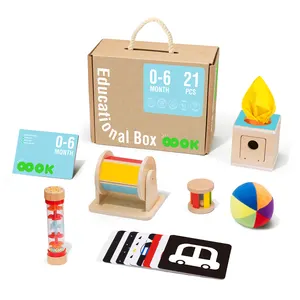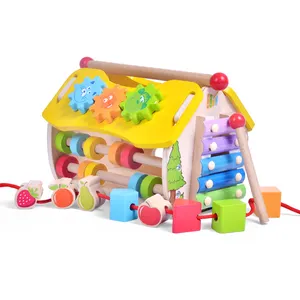(18770 products available)




















































































































































































































Colourful Rattles and Shakers
Developing its hearing and sight is important during the first 6 months of a baby, and the best baby toys at this stage are rattles and shakers. Most of the rattles will be incorporated with contrasting bright colour patterns and soft sounds, which will capture the attention of the infants. The babies can develop grip ability and hand coordination skills since these toys are lightweight and simple to hold. Rattles encourage sensory exploration because babies become more active by shaking and turning them.
Teething Toys
Teething toys relieve children with developing teeth within the age bracket of 0 to 6 months. Softer, safer materials are used in the manufacture of these toys to withstand chewing and sucking since this is a natural activity for babies as their teeth start to develop. Many teething toys can also be in the form of shapes and colourful designs, therefore attracting the attention of the babies apart from practical use. Teething toys can soothe gum irritation and promote oral health.
Soft Plush Toys
Stuffed animals and other plush toys are great companions for babies during the developmental phase. Ideally, most plush toys are manufactured from soft materials that are safe for babies to handle. The toys are designed in simplistic forms to ensure that they don't have small removable parts that can potentially be dangerous to children. Plush toys will also be introduced to the babies to facilitate emotional tightening, connection, and comfort.
Stacking and Nesting Toys
The other category of toys for babies aged 0-6 months includes stacking and nesting toys, which support cognitive development. Babies are excited about the bright colours and varied shapes of these toys as they learn how to arrange and fit them together with the help of these simple, soft, and safe stacking rings or nesting cups. These activities promote fine motor coordination and hand-eye coordination.
Bath Toys
Bath toys for babies aged 0-6 months are fun and very engaging. Usually, these toys are made from waterproof and quick-drying materials such as PVC or silicone, and they offer entertainment during bath time. Splashing around with simple forms, bright colours, and safe water toys introduces infants to basic concepts of buoyancy and movement. Bath toys also help develop motor skills and make bath activities more enjoyable.
Safe and Non-Toxic Materials
Giving priority to the safety of the baby will mean that suitable materials will be used so that baby products won't be harmful to one's health. Most toys have chemicals free plastic, silicone, and fabric that can be safely chewed on at this age. These materials have also been tested to ensure that they are BPA-free and phthalate-free, which is critical to beating the heat.
Durability
The durability of baby toys is important because babies have different ways of exploring their surroundings. Most of the toys for babies aged 0-6 months are made so that they can withstand dropping, chewing, and wetting. Using these guarantees premium materials that babies can continue to use for years. This durability means that the toys can be used for more than one child in the family and, hence, long-term investment for parents.
Sensory Elements
The development of sensory skills is very important at this stage, so 0 to 6 months baby toys introduce new textures, colour temperatures, and sounds. Usually, most baby rattles contain vaselined organs with surfaces to feel the noise-making organs inside them, baby gyms with hanging toys for targets of kicking and reaching have various dynamics, and the plush toys have different textures to touch. Engaging babies with their senses promotes cognitive development and keeps them busy for a long time.
Bright Colours and Designs
Visual appeal is important when choosing baby toys, and bright colours will capture the attention of little ones. Toys for dull moments are developed with vivid colour combinations and attractive designs to enhance better focus and interest. Moreover, this will help in the development of visual skills as well as in the introduction of colour recognition.
Easy to Clean
For children who are at the teething stage or even dropping the toys, it is so important to ensure that the toys used are hygienic. Generally, toys meant for infants can be washed by hand or in a washing machine, and many of them can be put in dishwashers. In addition, materials that are moisture resistant are used in the manufacture of these toys to eliminate the chances of dirt accumulation and therefore low chances of bacterial infections.
High-Quality Plastics
Most of the 0-6 months baby toys have been manufactured from high-quality plastics because these are lightweight and durable. It does not break easily; therefore, it can be used, thrown, and dropped easily by babies without breaking up into dangerous sharp edges. Moreover, as mentioned earlier, premium plastics are BPA-free, thereby increasing the safety of the children's products.
Silicone
Silicone is widely used within teething toys because it is soft, flexible, and durable. In addition, the material is heat-resistant, so it is safe for babies to use these toys even after cleaning them in hot water. Silicone is also very long-lasting, and therefore, it can withstand chewing by toddlers as they go through the teething process. Also, it is hypoallergenic and free of potentially dangerous substances, making it ideal for children with sensitive skin.
Cotton and Fabric
Developers of plush toys and cloth books normally use cotton or other fabric-based materials. Usually, these materials are chosen for their softness and flexibility, ensuring that the toys are comfortable for the babies. The fabrics are durable enough to allow washing and can undergo heavy handling by infants. Additionally, the use of different textured fabrics inside the plush toys aids in sensory discovery for the babies.
Rubber
Rubber is a natural and durable material for baby toys. It is very flexible, so good use can be made of it in teethers and bath toys. The material will not wear out easily, and it will not break into sharp or dangerous corners. Additionally, rubber is water-resistant; therefore, it is also ideal for bath toys that need to float in water.
Waterproof Fabrics
The durability of toys intended for bathing, such as those floating in water, is guaranteed by the use of waterproof fabrics or treated plastics. These materials will dry faster, which reduces the probability of mould formation. Furthermore, the toys can easily be cleaned to ensure hygiene, making the bath fun and safe for infants.
Safety Standards
When selecting toys for babies aged 0 to 6 months, safety is the first thing that should never be compromised. Since choking hazards are the main concern at this stage, it is advisable to go for toys that do not have small removable parts and that they have smooth rounded edges. Certifications like ASTM and CPSC will guarantee that the toy has met the required safety standards, which puts the mind of a parent at ease.
Developmental Benefits
The choice of toys should mainly be based on the developmental needs of the baby. Toys that stimulate sensor capabilities, such as those that incorporate sound, colour, and movement, encourage cognitive development at this stage. Toys that promote motor skills, such as stacking rings and baby gym toys, can also be useful for hand-eye coordination and fine motor skills.
Ease of Cleaning
The hygiene of toys is essential for the health of the baby. In this case, choose toys that are easy to clean, have water-resistant materials, and are safe to put in a dishwasher or washing machine. The materials used in making these toys should also dry quickly to reduce the possibility of wet and dirty toys that harbour bacteria.
Engagement and Interactivity
The more engaging a toy is, the more it will encourage babies to explore and play. Toys that make sounds, vibrate, or have moving parts will hold the child's attention for a longer duration and increase the level of activity. Ensure that the toys can be easily grasped and manipulated by tiny hands to foster independent play and interaction.
Longevity and Durability
All the toys meant for infants must be very durable since the babies will chew, drop, and handle them in different ways. When looking at the cost from the angle of a parent, it is important to select good-quality toys that can be used for more than one child or can even be passed to other people. These toys must perform effectively and deteriorate over time.
Yes, specifically designed 0-6 month baby toys are safe for teething. They are made of soft, durable silicone, rubber, or natural latex. These materials are flexible enough to give comfort and support to babies experiencing teething discomfort, and they also ensure no sharp edges that can harm the baby during the chewing process.
Toys like rattles with contrasting textures and surfaces, colourful plush, and bath toys promote sensory development. These toys stimulate sight, hearing, and touch, laying the foundation for overall cognitive development while keeping the baby engaged with different sensations.
Most baby toys for this group are washable with either hot or cold water, and many are safe for the dishwasher. A lot of the plush toys can be washed by hand and can also be kept dry. Toys made of silicone and plastic are capable of withstanding frequent sanitation without any damage.
The most important thing to consider when selecting baby toys is safety. When choosing materials, make sure they are BPA-free and phthalate-free, and avoid small parts. Choosing toys based on their developmental benefits, engagement factor, and ease of cleaning is good while ensuring they meet safety standards.
Bright-coloured stacking rings and nesting cups facilitate hand-eye coordination and fine motor skills in infants while introducing them to new shapes and concepts. These toys provide engaging experiences, laying a solid foundation for future learning and promoting cognitive growth.